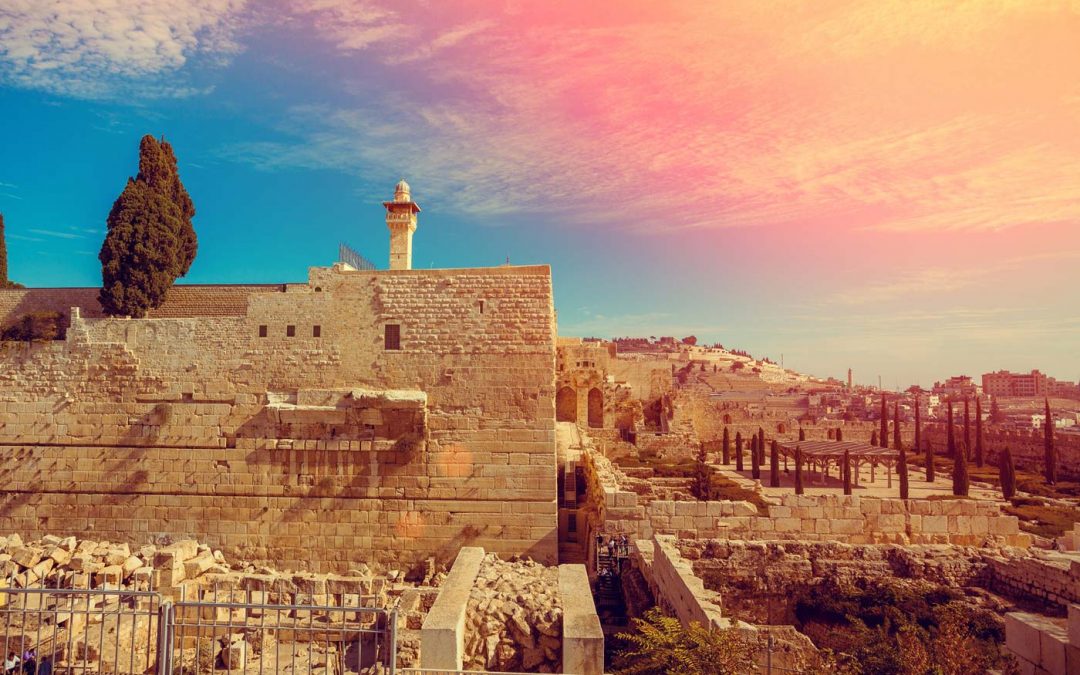21-27 MAY 2018
‘Jerusalem’ is Hebrew for ‘place of peace.’ It is the only major metropolis that occupies a central role in three traditions: Judaism, Christianity, and Islam. Viewed literally, the city’s title is erroneous as its location has been the hub of perpetual conflict. Viewed symbolically, however, Jerusalem represents the ‘place of peace’ in the cosmos, a station to be attained by struggle, a destination in which higher possibilities materialize.
“Continue to observe,” says Peter Ouspensky, “and you will find that there is a place in you where you are quiet, calm and nothing can disturb you – only it is difficult to find the way there.” We will gather in Jerusalem to explore this inner ‘place of peace,’ how it was historically represented by this ancient city, how this state of peace can only be sustained by struggle, and how the reward always dwarfs the price of its attainment.
Islam
 We will travel through the alleys of the Muslim quarter and reach the Dome of the Rock that dominates the temple mount. This mosque houses the rock from which the Prophet Muhammad allegedly sprang up during his night journey to heaven. We will consider what is ‘heaven’ in the micro-cosmos. By which efforts do we spring up to our higher parts? And what ‘rock’ must lay at the foundation of our climbing?
We will travel through the alleys of the Muslim quarter and reach the Dome of the Rock that dominates the temple mount. This mosque houses the rock from which the Prophet Muhammad allegedly sprang up during his night journey to heaven. We will consider what is ‘heaven’ in the micro-cosmos. By which efforts do we spring up to our higher parts? And what ‘rock’ must lay at the foundation of our climbing?
Christianity
 We will retrace the footsteps of Jesus wading through the Via Dolorosa, carrying his cross toward Golgotha, and consider the inner meaning of this dramatized journey. What is ‘death’ as symbolized by crucifixion? And why did this ‘way of sorrow’ consist of 14 stations? We will draw from subsequent Esoteric Christian commentary to gain a different point of view on the tragedy that concluded the life of the founder of Christianity and triggered the world’s largest religion.
We will retrace the footsteps of Jesus wading through the Via Dolorosa, carrying his cross toward Golgotha, and consider the inner meaning of this dramatized journey. What is ‘death’ as symbolized by crucifixion? And why did this ‘way of sorrow’ consist of 14 stations? We will draw from subsequent Esoteric Christian commentary to gain a different point of view on the tragedy that concluded the life of the founder of Christianity and triggered the world’s largest religion.
Judaism
 The city of Jerusalem was traditionally established on Mount Moriah, where Abraham was asked by God to sacrifice his beloved son Isaac. Abraham is tested to the very end, and right as he is about to strike his son, is spared by God from doing so. “People think they have to sacrifice something that they have,” said George Gurdjieff. “In actual fact they have to sacrifice only their fantasies.” As we survey the remains of the second Jewish temple and descend through tunnels to explore its foundations, we will consider the role of sacrifice in attaining inner peace.
The city of Jerusalem was traditionally established on Mount Moriah, where Abraham was asked by God to sacrifice his beloved son Isaac. Abraham is tested to the very end, and right as he is about to strike his son, is spared by God from doing so. “People think they have to sacrifice something that they have,” said George Gurdjieff. “In actual fact they have to sacrifice only their fantasies.” As we survey the remains of the second Jewish temple and descend through tunnels to explore its foundations, we will consider the role of sacrifice in attaining inner peace.
Conference of the Birds
 Attar portrays the journey to inner peace as a pilgrimage of birds traveling towards a godlike phoenix. The journey consists of seven valleys and is fraught with difficulty. Most find excuses to quit; only few birds arrive at the coveted destination.
Attar portrays the journey to inner peace as a pilgrimage of birds traveling towards a godlike phoenix. The journey consists of seven valleys and is fraught with difficulty. Most find excuses to quit; only few birds arrive at the coveted destination.
We will take advantage of this physical gathering to perform Attar’s Conference of the Birds. Our evenings and nights will be spent in rehearsal. Each visitor will formulate their chief excuse in making efforts to Be. These formulations will be woven into a script to be enacted by those visiting under the direction of Ansley Braverman.
Join us for an esoteric exploration of the ‘City of Peace.’ Observe the conflict between inner and outer interpretations of Islam, Christianity, and Judaism. Witness how the inner meaning that sparked these traditions is still accessible, if only we know where to seek it. Experience the opportunity of learning with other fourth way students during the day and rehearsing with them at night. Use the effort, inspiration, and intensity of this gathering to generate your own ‘inner peace.’
“This quiet place is not a metaphor,” concludes Ouspensky; “it is a very real thing.”

